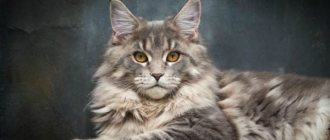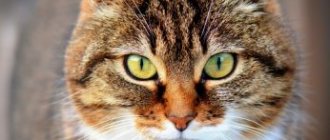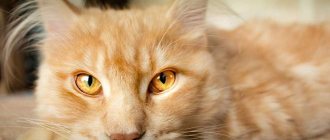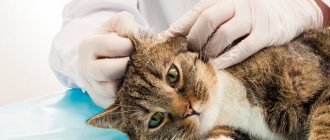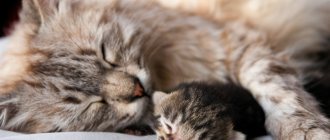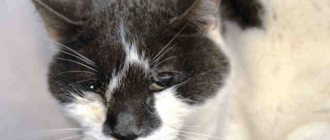In the last century, the age limit for cats rarely reached 10 years, and only a few lived to reach the 15-year mark. True, in those days the main task of cats was to protect food supplies from rodents. Hence injuries, infections and early death.
Now life expectancy for cats has increased significantly thanks to veterinary care, quality nutrition and a calmer lifestyle.
Stages of a cat's life cycle
The life of any cat can be divided into several stages.
Infancy (from birth to six months)
The first six months of a baby’s life are the most significant and eventful. Ten days after birth, these are blind sucklings, whose whole world is concentrated in the warmth of the mother’s body and the nipple with milk.
By two months, kittens become quite independent, begin to feed on their own, and learn to use a litter box.
Until three or four months, the pets usually do not leave the nursery and the mother. From four to six, they resemble playful children on the cusp of adolescence.
Youth (from six months to two years)
In almost all breeds, by six months the kitten is at the beginning of puberty. Physically, he is already quite developed, almost independent.
Usually at one year the female is already able to give birth and feed kittens, although it is better if pregnancy occurs a little later, at least at 18 months. Cats mature more slowly - up to one and a half years, and in some breeds up to two or three years.
Youth (three to six years old)
Animals are considered conditionally young when they are between two and six years old. This age approximately corresponds to 20-40 years of a person. It is at the age of six that it is customary in nurseries to remove an animal from breeding.
But with good care, pets are active, healthy and capable of producing full-fledged offspring for much longer - at least up to seven to ten years.
Maturity (seven to ten years)
A cat from seven to ten years old is considered a mature individual. About the same as a person aged 40-55 years old. The animal is in the prime of life, behaves calmly and reservedly.
Older cats (eleven to fourteen years old)
From 11 to 14 years old, the cat is in old age, corresponding to human 55-70 years. If the pet does not suffer from any chronic diseases, then neither he nor the owner will have any special problems in life. Sleep time increases, whims in choosing food may appear, and there is no particular desire for outdoor games.
Old age (over fifteen years)
Pets over 15 years old can be considered 80 year olds. They are calm, unhurried, affectionate, need the attention and care of their owner, and express their devotion more clearly.
This division into age groups is very arbitrary. Many animals at 15 years old are still vigorous, playful and active. There is a known cat of the Nibelung breed that lived 36 years. She gave birth to and nursed her last kittens at 28. By the way, read about long-lived cats on our portal.
What is sterilization?
In order to choose the type of sterilization, you must consult your veterinarian.
Sterilization is one of the types of abdominal operations in which the genitals of an animal are removed . It can be complete or partial. A cat's uterus and ovaries may be removed, or only the uterus or only the ovaries may be removed. There is an operation to tie the fallopian tubes. Each type of procedure has its own characteristics, advantages and disadvantages, which it is better to familiarize yourself with before the procedure and consult with a specialist.
What should owners know about sterilization?
Owners who decide to sterilize their pet should know about the optimal age for the operation and postoperative care. As for age, it is better to sterilize your cat before her first heat . The optimal age is considered to be from 8 months to one and a half years . The older the animal, the greater the risk of complications after surgery.
During the postoperative period, you need to give your pet maximum attention and care!
You must also understand that the procedure is very serious and is carried out in the animal's abdomen. The rehabilitation period for cats is on average 10 days . During these times, it is better not to disturb the cat, but to feed it fully (choose special dry food, canned food, boil chicken). During the healing period of the suture, the cat should not lick it so that it does not come apart, so it is better to put a blanket and collar on it.
The following days after the operation, the seam must be wiped with a special solution, so the collar will prevent the cat from licking the wound.
Life of a street and indoor cat
Life expectancy is affected by habitat. Well-groomed and caressed domestic cats live much longer than their street counterparts. The latter have to survive, get food, and hide from the cold in winter. In the cold, death from hypothermia overtakes animals quite quickly.
Kittens born in the basement or on the street die in the first months of life in 90% of cases. The reason for this is weakened immunity, lack of heat and viral diseases. Only the strongest survive, but they have yet to prove their strength in street fights. It is not surprising that they have a short life span - few live up to 7 years, and a 10-year-old street cat will be considered a long-liver.
Animals that end up outside from home find themselves in even worse conditions. Most often, the owners refuse them, indifferently throwing them away like an unnecessary rag. The chances of living at least a year on the street for cats unadapted to such conditions are negligible.
The life of a pet is a different matter. There is good food in the bowl, a warm bed in the room. Vitamins and vaccinations protect against diseases; at the slightest deviation, a caring owner will take all measures to restore the pet’s health.
Advantages and disadvantages
Let's note the advantages of a neutered cat:
- Reducing the number of stray animals - the owner will not suffer from remorse for dooming young animals to a hungry and cold existence on the street.
- The risk of diseases of the mammary glands and genital organs is reduced - even with targeted mating, the risk remains, let alone casual “street” sexual contacts.
- Changing the hormonal levels improves the pet’s mood - the amount of nighttime entertainment and loud yelling is reduced.
- The cat stops marking its territory - after surgery, the reproductive instinct disappears.
Let's move on to the disadvantages after sterilization surgery:
- Surgical intervention in a living organism itself can result in tragedy. You should take your choice of clinic seriously and talk to your doctor before surgery.
- There are frequent cases of bleeding or suppuration of the wound after surgery, but modern drugs can easily solve this problem.
A sterilized cat is 90% less susceptible to genital cancer than its unvaccinated counterpart.
What affects the life expectancy of cats
With proper care and the absence of genetic or chronic diseases, many indoor cats can live up to 20 years or more. The average life expectancy is 15-17 years, with spayed and neutered animals living 2-4 years longer.
Factors that reduce life expectancy
First of all, it is the habitat. Adequate and regular nutrition, absence of temperature changes, these factors significantly affect life expectancy. Unbalanced nutrition - food from the owner's table, cheap food that does not contain the required amount of nutrients and vitamins, often leads to the development of endocrine diseases and the premature death of the pet.
Also, the period depends on the breed. Genetic predisposition can be traced, as a rule, only in purebred animals. Thus, British cats easily live up to 15 years, and Persian cats - up to 20, but “classic” and “extreme” Persians do not have such longevity and rarely live even up to 15 years. However, breed itself is not an indicator of longer life. Since these cats often have genetic defects that can be caused by inbreeding. For this reason, for example, it is dangerous to knit “Scots” and “British”.
Sexual instinct is another factor influencing life expectancy. Outdoor cats may go into heat three times a year, resulting in pregnancy. Childbirth somewhere in the basement, feeding and pregnancy again greatly depletes the body, doomed to a half-starved existence. The result is a short life.
In domestic unsterilized cats and female cats, hormonal surges and the inability to realize natural instincts can lead to diseases, so in this case, sterilization actually prolongs their life.
The allotted period can be reduced by:
- lack of vaccination and preventive measures;
- free walking, which can end in death under the wheels of a car, a fight with a dog or street cat;
- infection with infectious diseases.
Factors that increase life expectancy
Important factors that will help your pet live as long as possible are:
- Proper nutrition. Food must be balanced, no matter whether it is natural or industrial food. The pet must receive the necessary vitamins and minerals. Feed must be chosen at least at the premium or super-premium level.
- Mandatory and timely vaccination, regular preventive examinations and immediate contact with a veterinarian in case of any deviations in the health and behavior of the pet.
- Sterilization or castration, after which you need to adhere to a special diet.
- Protection from dangers. For domestic cats, this is, first of all, the street, open windows and vents. It is advisable to exclude self-walking and cover the windows with special nets (mosquito nets will not help, you need an anti-cat net).
Regular removal of parasites and preventive treatment will have a positive effect on the health of the animal, and therefore on its life expectancy. Even if the cat has never gone outside in its life, it needs to be treated for fleas and helminths once every 3 months.
Factor table
| Wednesday | Domestic cats are less susceptible to viral diseases and are protected from injury. |
| Nutrition | When balanced with essential vitamins and minerals, it significantly prolongs life. |
| Genetic predisposition | Many artificially bred breeds are susceptible to some kind of disease. |
| Sterilization | Neutered cats do not suffer from reproductive pathologies and are not exposed to stress; sterilized cats live longer than those who often gave birth to kittens. |
| Stress | Street cats are constantly exposed to stress from cold, hunger, and dangers; domestic animals have a calmer life. |
| Predisposition to chronic diseases | If you start treatment in the early stages of the disease, you can significantly prolong the life of your pet; without help, animals with diabetes do not live longer than 4 years, with urolithiasis - longer than 5. |
Record-breaking cats
Long-livers among the cat family are quite common. It is difficult to say what exactly leads to this result. Perhaps this is good heredity, proper nutrition, a happy life with a beloved owner.
The record holder, listed in the Guinness Book, lived to be 38 years old. It was a cat named Cream Puff, her owner lived in Texas. However, there are other representatives who have surpassed this record.
One of these is a cat from the UK who lived to be 43 years old. If we translate into human terms, then this is about 175-180 years. Her name is Lucy, and she is still alive, although she does not even show signs of old age, with the exception of deafness.
Another cat living in Australia is a representative of the British breed named Lady Catalina. She is currently about 38 years old. The animal also leads an active lifestyle.
In Russia there are no particularly long-livers or they are simply unknown. This can be attributed to the fact that owners from Russia treat their pets with less trepidation. Although this is most likely because it is not customary in the country to advertise various kinds of records in this way. Most likely, many people have a pet that has long passed its due date.
Long-lived cats
Table of average life expectancy by breed, features and diseases
| Breed | average life expectancy | Characteristic diseases and features |
| Persian | 15-20 | “Exotics” live longer than the “classical” and “extreme” Persians.
|
| Siamese | 15-20 | “Purebreds” are more likely to develop diseases than mixed breeds; there may be problems with the kidneys and eyes.
|
| British | 12-15 |
They rarely suffer from cancer, have good immunity, it is important to maintain an active lifestyle and feed them with high-quality food. |
| Scottish Fold (Scottish Fold) | 15-20 |
They have good immunity, but it is important to choose the right diet to maintain the cat’s vital activity. |
| Siberian | 15-17 |
However, 25 years is not the limit for a “Siberian” if you keep your pet properly, since it has no tendency to develop genetic diseases. |
| Russian blue | 12-16 | A domestic cat can live longer with care and affection if it is regularly shown to a veterinarian and its nutrition is properly organized.
|
| Abyssinian | 15-17 |
It is important to regularly monitor your pet's health and take your pet to the veterinarian. |
| Bengal | 12-15 |
One of the strongest and hardiest breeds, it is only important to feed and care for them correctly. |
| Sphinx | 12-15 |
With the right approach to maintenance, it can live more than 20 years, and even at such a respectable age it has excellent immunity. |
| Maine Coon | 14-16 |
|
Maine Coon
How to extend the life of a Persian: care and maintenance
Proper care of your pet helps to prolong the life of a Persian. For elite animals, it is much more difficult, since breeders sacrifice their health for the sake of appearance.
Be sure to read:
Burmese sacred cat: appearance, character, price, care and maintenance of the breed
Grooming
For combing cats, choose steel combs with long teeth rounded at the ends. You should not use a powder brush.
This is a tool for professional grooming of Persians, which is used in the process of preparing the animal for exhibitions.
Steel combs are preferred for grooming cats.
Only the paws and muzzle are treated with it. Combing is carried out daily. At the time of shedding, it is necessary 2 times a day. Cats are taught to brush from an early age.
Bathing
Bathing your Persian is a mandatory procedure. I need it once a month. When shedding, it is better to bathe your pet more often to avoid the formation of mats.
Use special shampoo for long-haired cats for washing. Persians are accustomed to water from childhood.
After washing, dry the cat first with a terry towel, and then dry the fur with a hairdryer. You should not leave your Persian to dry naturally due to the risk of tangles forming. Getting used to a hairdryer, like bathing, begins in childhood.
Hygiene of the nose, eyes and ears
Hygienic procedures for the eyes, ears and nose are a mandatory step in caring for an animal.
In their absence, the pet will quickly begin to get sick. The ears are wiped once a week with a cotton swab dipped in cat ear care lotion.
Hygienic procedures for the eyes, ears and nose are a mandatory step in caring for an animal.
The eyes are wiped with a soft cloth moistened with a special solution (the product is sold in a pet store). The procedure is carried out at least once every 2 days, and it is advisable to do it daily.
Wipe the nose once a week with a clean cloth moistened with a water infusion of calendula. If there is heavy discharge from the nose, then cleaning is carried out once a day, using a product prescribed by a veterinarian.
Feeding
The animal's food is selected according to its age. If ready-made food is given, then choose one intended for young, adult or aging animals.
Economy class meals cannot be used.
With natural feeding, 40% of the diet should be meat, 20% milk proteins and eggs, 15% offal, 15% vegetable fiber and 5% lean sea fish. Natural feeding is a priority for any cat.
Be sure to read:
The Ragamuffin is a breed of domestic cat derived from crossing the Ragdoll.
Table of maximum life expectancy by breed
The Guinness Book of Records contains many records for life expectancy in cats. However, for most pets, some pattern can be deduced.
| Maximum age (years) | Cat breeds |
| 20 |
|
| 19 |
|
| 18 |
|
| 17 |
|
| 16 |
|
| 14 |
|
Procedure options
In addition to the classical operation, it is worth highlighting several types of sterilization.
Chemical method
It is equally suitable for both sexes and consists of introducing drugs into the animal’s body that reduce or completely suppress sexual activity. In Russia, drops or tablets are common; intramuscular injections are used less frequently.
And the obvious advantages of the method can be identified:
- Reversibility . You can always stop taking medications and restore the possibility of conceiving offspring
- Painless . Even with injections, the sensations are not comparable to a full-fledged operation.
- Availability. The ability to take medications at home without the intervention of a specialist.
Unfortunately, often, all the benefits are outweighed by the unpredictability of the body's reaction to taking medications. Starting with hair loss and the appearance of excess weight, ending with malignant tumors.
Ionizing radiation
For sterilization, ionizing radiation is used to treat the genitals, suppressing activity for up to several years. Among the advantages it is worth highlighting:
- Fast efficiency. It only takes a few sessions to see results.
- Possibility of treatment at a young (up to 6 months) age.
The disadvantages include high cost and the presence of a highly qualified specialist. The radiation dose is strictly individual and is calculated based on the breed, weight, height, and age of the animal.
What can you do to prolong your cat's life?
Don’t despair if your pet is approaching the “average” age. Each owner can extend the life of his pet by following only a few rules:
- closely monitor the well-being of your furry friend and immediately contact a veterinarian at the slightest deviation in behavior;
- promote cat physical activity;
- do not allow self-walking;
- sterilize the animal;
- wisely select a diet containing proteins, vitamins, and minerals;
- take care and give affection to your pet, do not expose it to stress.
Approximately 30% of domestic cats suffer from chronic renal failure. It is impossible to completely cope with the disease, but if you notice it in time, you can maintain your pet’s health and significantly extend its life.
Differences between castration and sterilization
When sterilized, the animal will not have the opportunity to produce offspring, but the organs are not touched, basic hormonal functions, marking the territory - all this will be inherent in the pet. Castration occurs through the removal of the ovaries/testes, which affects hormonal levels - inactivity, they stop marking territory, and screaming in the spring.
There is an opinion among professionals that castration is more suitable for cats . During sterilization, hormonal surges occur, leading to an imitation of pregnancy, but without its logical conclusion. High risk of cancer. Everything turns into extreme stress for the animal, loss of appetite and/or activity.
INTERESTING! A cat can be neutered after pregnancy, just wait until the first heat. Although this moment is individual for tailed animals.
How long do cats live in human age?
It is a mistaken belief that one year of a cat's life should be equal to seven human years. In the International Veterinary Passport, the first year of a cat’s life is equated to 18 human years, and an animal that has crossed the 20-year mark is considered a long-liver: by human standards, it is already 100 years old.
Biologists have deduced the approximate age ratio of humans and cats.
Table: how to determine the age of a cat by human standards
| Cat age, months | Person's age, years |
| 1 | 1,3 |
| 2 | 2,5 |
| 3 | 3,75 |
| 4 | 5 |
| 5 | 6,3 |
| 6 | 7,5 |
| 7 | 8,75 |
| 8 | 10 |
| 9 | 11,7 |
| 10 | 12,5 |
| 11 | 13,75 |
| Cat age, years | Person's age, years |
| 1 | 15 |
| 2 | 24 |
| 3 | 28 |
| 4 | 32 |
| 5 | 36 |
| 6 | 40 |
| 7 | 44 |
| 8 | 48 |
| 9 | 52 |
| 10 | 56 |
| 11 | 60 |
| 12 | 64 |
| 13 | 68 |
| 14 | 72 |
| 15 | 74 |
| 16 | 76 |
| 17 | 78 |
| 18 | 80 |
| 19 | 82 |
| 20 | 84 |
How long a domestic cat will live depends on the person. Having taken responsibility for the life of a pet, it is important to maintain its health: properly organize nutrition and timely vaccination.
Care and attention, treating it not as a toy, but as a full member of the family, will help prolong the life of your pet.
Maximum age of a cat recorded in history
Various pets are called the oldest cats in the world.
The official record holder for longevity, the Guinness Book of Records names the cat Cream Puff, whose life expectancy was 38 years and 3 days.
Previously, the record belonged to a Frenchman named Granpa, who lived for 34 years, but it is difficult to say how honest this record was: the owners found the animal as an adult, and supposedly the veterinarian said that he was about 5 years old.
If the veterinarian really said this, determining the age of cats by their teeth is not very reliable: grinding down the incisors depends on the bite, the animal’s nutrition, its state of health and a host of other factors.
Nature is rich in miracles, but veterinarians are skeptical about reports of 30-year-old cats: not all experienced doctors have encountered animals that live even 23 years.
Description of the breed
Persian cats are considered one of the very first pets to be domesticated. There are many varieties of these animals that differ in color. However, the main feature of these cats is their nose. There are three types of Persian cats:
- British. The nose is straight, located below the level of the visual organs.
- European. The organ is localized at the level with the lower eyelids.
- Extreme. The nose is at the level of the upper eyelids.
Previously, there was one type of these cats called peakface, but breeding them was prohibited because the animals had a lot of health problems. Due to the shape of their faces, the pets experienced difficulty breathing, increased production of tears, malocclusion, and problems eating. In this regard, their life expectancy was no more than 10 years.
